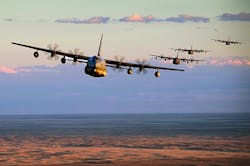Air Force readies to buy 11 C-130J military transport aircraft for cargo, special ops, refueling
WRIGHT-PATTERSON AFB, Ohio, 18 March 2016. The U.S Air Force is preparing to buy 11 new Lockheed Martin C-130J four-engine turboprop military transport aircraft with digital avionics under terms of a $106 million order announced this week.
Officials of the Air Force Life Cycle Management Center at Wright-Patterson Air Force Base, Ohio, are asking the Lockheed Martin Corp. Aeronautics segment in Marietta, Ga., to buy long lead items for the 11 aircraft that will be in several configurations.
Long-lead-item orders will enable Lockheed Martin to buy components and equipment that typically take a long time to acquire so the company can complete the new aircraft as soon as possible after the Air Force awards the future construction contract.
The Lockheed Martin C-130J Super Hercules is the latest and most technologically advanced version of the C-130 four-engine turboprop military transport aircraft. Compared to the first versions of the C-130 that entered service in the mid 1950s, the C-130J has new engines, flight deck, and other systems, and is the latest in the longest continuous production run of any military aircraft in history.
The long-lead items are for two new C-130J-30s, three HC-130Js, five MC-130Js, and one KC-130J. The C-130J-30 is a stretched version of the standard C-130J that is 15 feet longer than the standard aircraft. The HC-130J is an extended-range search-and-rescue version of the Super Hercules, while the MC-130J is a special operations version of the plane. The KC-130J, meanwhile, is a aerial refueling aircraft.
Related: Lockheed Martin to upgrade obsolete data and graphics processors in C-130 aircraft displays
The C-130J entered service in 1999, and can be sent on missions in harsh environments, and can touch down on austere landing strips. Versions of the plane are for combat, humanitarian, special operations, aerial refueling, firefighting, and search and rescue mission.
The Super Hercules is one of the world’s most advanced tactical airlifter aircraft, and fills roles in special operations, aerial refueling, close air support, search and rescue, and personnel recovery.
Externally similar to the classic C-130, the C-130J has digital avionics with including head-up displays, Rolls-Royce AE 2100 D3 turboprop engines with composite scimitar propellers, and reduced crew requirements.
Compared to earlier version of the C-130, it has 40 percent greater range, 21 percent faster maximum speed, and 41 percent shorter takeoff distance. It comes in a standard-length or stretched variant. The plane can operate out of 2,000-foot dirt strips in high mountain ranges, transport more than 40,000 pounds of cargo and supplies.
Related: BAE Systems to develop electronic warfare (EW) suite for Special Operations C-130J aircraft
The C-130J, which is crewed by two pilots and a loadmaster, has four L-3 multifunction liquid crystal displays for flight control and navigation systems. Its dual mission computers from BAE Systems operate and monitor the aircraft systems and advise the crew of status.
The C-130J cockpit has the Northrop Grumman low-power color radar display with digital moving map. The plane has a Honeywell dual embedded global positioning system and inertial navigation system, enhanced traffic alerting and collision avoidance system.
The plane's ATK AN/AAR-47 missile warning system uses electro-optic sensors to detect incoming missile threats. Its BAE Systems AN/ALE-47 countermeasures system can dispense chaff, flares, and active expendable decoys. The Super Hercules also has the Northrop Grumman Large Aircraft Infra-red Countermeasures (LAIRCM) system.
On this contract Lockheed Martin will do the work in Marietta, Ga., and should be finished by July 2017. For more information contact Lockheed Martin Aeronautics online at www.lockheedmartin.com/us/aeronautics, or the Air Force Life Cycle Management Center at www.wpafb.af.mil/aflcmc.

